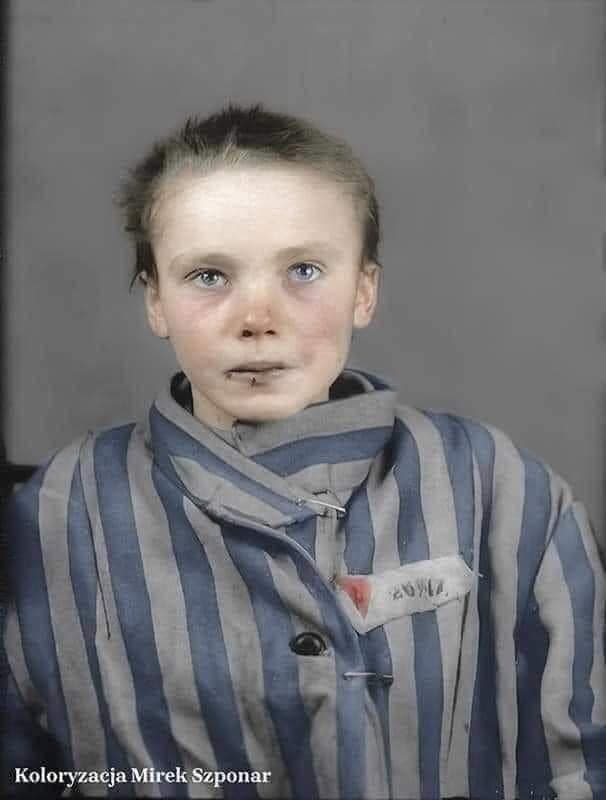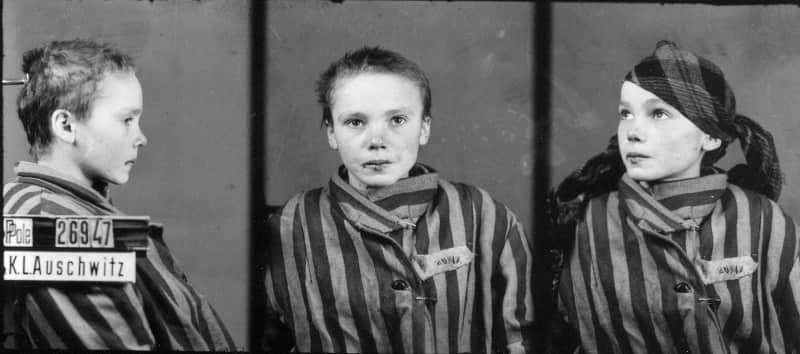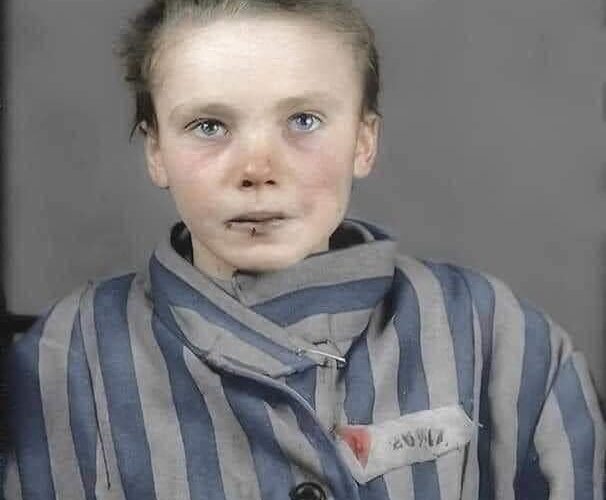The TRAGIC Execution Of Czesława Kwoka – The Girl Of Auschwitz

Born on August 15, 1928, in Wólka Złojecka, a small village in Poland, Czesława Kwoka was just a child when she was swept into one of history’s darkest moments.
Her story, particularly the heart-wrenching photograph taken shortly before her death, continues to resonate as a symbol of the cruelty and inhumanity that took place within the walls of Auschwitz.
Early Life and Family
Czesława Kwoka was born into a Roman Catholic family in southeastern Poland, an area that became deeply affected by the Nazi invasion during World War II. Her mother, Katarzyna Kwoka, was a devout and resilient woman who cared for her daughter in difficult circumstances. Unfortunately, not much is documented about her father, and he likely was either absent or perished early in the war. Like many Polish families, the Kwokas found themselves trapped in the horrors of the German occupation.
Poland was brutally divided by Nazi forces, and anyone resisting the regime or deemed undesirable by the Nazis, including ethnic Poles, were targeted. Czesława and her mother were among the many civilians caught in the mass deportations ordered by Nazi officials. As part of Adolf Hitler’s plan to “Germanize” the territories, Polish nationals were subjected to forced relocations, executions, and imprisonment.
In December 1942, when Czesława was only 14 years old, both she and her mother were arrested by the Nazis. Their crime? They were simply Polish, living in an area targeted for resettlement as part of the Nazi occupation.
Imprisonment in Auschwitz
Czesława and her mother were deported to Auschwitz, the notorious concentration camp located in Nazi-occupied Poland. Auschwitz became the largest of the Nazi concentration and extermination camps, where over 1.1 million people, including Jews, Poles, Roma, and Soviet POWs, were murdered.
Upon their arrival at Auschwitz on December 13, 1942, Czesława and her mother were stripped of their identities and given numbers. Czesława became Prisoner No. 26947. Life in Auschwitz was a daily fight for survival. Prisoners were subjected to inhumane conditions, including forced labor, starvation, disease, and frequent beatings.
In a cruel twist of fate, Czesława’s mother, Katarzyna Kwoka, died in Auschwitz shortly after their arrival, leaving the young girl alone in the concentration camp. Historical records suggest that Katarzyna may have been executed or succumbed to the brutal conditions in early February 1943.
The Infamous Photograph and Her Execution
In March 1943, Wilhelm Brasse, a Polish political prisoner forced to work as a photographer for the Nazis, captured a series of photographs of Czesława. The photographs depict a terrified, beaten girl who looks directly at the camera, her face bruised and her lips swollen. These haunting images offer a glimpse into the brutal violence she faced at the hands of Nazi guards.
Brasse later recalled how the SS guards mistreated the young girl just before her photograph was taken. According to his testimony, a female Nazi guard hit Czesława in the face, leaving her bleeding and terrified. Despite the physical abuse, the young girl stood before the camera with quiet dignity, unaware that she would soon be executed.

Czesława Kwoka was executed on March 12, 1943, at the age of 14. Though the specific details surrounding her death remain unclear, it is widely believed that she was killed either by lethal injection or gas, both common methods used by the Nazis to exterminate their victims. Her short life came to an abrupt end in the death factory that was Auschwitz.
A Legacy of Remembrance
Czesława Kwoka’s story, may have faded into obscurity had it not been for the photographs taken by Wilhelm Brasse. These images have become iconic in serving as stark reminders of the innocence lost during this tragic period.
Her story has also been widely shared in museums, documentaries, and exhibitions. Czesława’s youth, vulnerability, and brutal treatment at Auschwitz have made her a powerful symbol of the countless lives destroyed by hatred and intolerance.
The Czeslawa Kwoka Family Legacy
Though much of the Kwoka family’s personal history was erased during the war, Czesława’s legacy has lived on through survivors and witnesses like Wilhelm Brasse. He later stated in interviews that taking the photograph of the beaten girl was one of the moments that haunted him the most after the war. Through his testimony, we can understand the profound suffering that Czesława endured.
The story of Czesława Kwoka is not only a tale of a young girl’s tragic fate but also a reminder of the importance of remembering the past. Her story, marked by her arrest, the loss of her mother, and her eventual execution at Auschwitz, stands as a testament to the resilience and dignity of innocent victims caught in the machinery of terror. Through her haunting photograph, the world is forced to remember the consequences of unchecked hatred, and her legacy endures as a symbol of all those who were lost.
Frequently Asked Questions (FAQ) About Czesława Kwoka
1. Who was Czesława Kwoka?
Czesława Kwoka was a 14-year-old Polish girl who was arrested by the Nazis in December 1942, deported to Auschwitz, and executed on March 12, 1943.
2. Why was Czesława Kwoka sent to Auschwitz?
Czesława was sent to Auschwitz because she was a Polish Catholic living in an area targeted for resettlement by the Nazis. Many ethnic Poles were arrested and deported as part of Hitler’s plan to “Germanize” occupied territories.
3. What happened to Czesława Kwoka’s family?
Czesława was deported to Auschwitz with her mother, Katarzyna Kwoka. Her mother died in Auschwitz in early 1943. Not much is known about her father, and Czesława herself was executed shortly after her mother’s death.
4. Why is Czesława Kwoka’s photograph so famous?
Her photograph, taken by Wilhelm Brasse, a prisoner forced to photograph inmates at Auschwitz, has become iconic because it captures her youth, terror, and physical abuse.
5. How did Czesława Kwoka die?
Czesława was executed on March 12, 1943, in Auschwitz. Though the exact method of her execution is unclear, it is believed she was killed either by lethal injection or in the gas chambers.
6. Who took the famous photograph of Czesława Kwoka?
The photograph was taken by Wilhelm Brasse, a Polish political prisoner forced to work as a photographer in Auschwitz. He later recalled the pain and terror that Czesława experienced before her photograph was taken.

